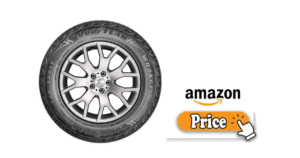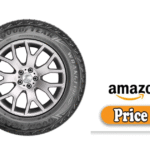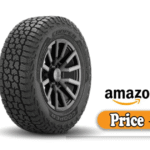In today’s world of complex tire options, choosing the right set for your car, truck, or SUV is more than just about brand loyalty; it’s about performance, safety, longevity, and, of course, cost.
Among the top-tier tire manufacturers, Goodyear has carved a long-standing reputation for reliability, innovation, and performance across a wide range of vehicle types.
But how do Goodyear tire prices compare? Are they still worth the premium, or are more affordable brands catching up? This article takes a deep dive into the latest Goodyear tire models, their price ranges, what they offer in return, and how they stack up against the competition.
What I Like
Goodyear’s strengths go well beyond just name recognition. Here’s what stands out the most about this iconic brand:
1. Top-Tier Performance Across All Categories
Whether you’re commuting, off-roading, or driving a high-performance vehicle, Goodyear has a specialized tire for you, and they perform at or near the top in their respective categories.
2. Innovative Technology
From Weather Reactive Tread Zones to RunOnFlat Technology, Goodyear has been consistently ahead of the curve in tire innovation. Their Eagle F1 and Assurance lines showcase advanced engineering that enhances both safety and performance.
3. Excellent Warranty Coverage
Many Goodyear tires come with warranties ranging from 50,000 to 85,000 miles, giving you added peace of mind with your investment.
4. Strong Wet and Snow Performance
Several Goodyear tires, including the Assurance WeatherReady, carry the 3PMSF (Three-Peak Mountain Snowflake) symbol, certifying them for severe snow conditions.
5. Wide Availability and Service Network
With thousands of authorized retailers and service centers, Goodyear tires are incredibly easy to buy and maintain. Plus, you’ll often find seasonal deals, rebates, and bundle offers.
What Could Be Better
No tire brand is perfect, and Goodyear is no exception. Here are a few areas where they could improve:
1. Higher Price Point
Goodyear tires generally fall on the more expensive side, even within their product range. While the quality is there, the cost may be prohibitive for some budget-conscious buyers.
2. Road Noise in Certain Models
Some models, particularly older touring tires like the Assurance All-Season, can produce more road noise as they wear, especially at highway speeds.
3. Soft Sidewalls in Comfort-Focused Lines
While models like the Assurance ComfortDrive offer excellent ride quality, their softer sidewalls can slightly reduce cornering performance, especially on sportier vehicles.
4. Limited Budget Options
Unlike brands like General or Cooper, Goodyear doesn’t offer as many truly “budget” tires, which might steer price-sensitive consumers elsewhere. 👉🏿👉🏻 Check the Latest Price and Offer at Amazon 👈🏻👈🏿
👉🏿👉🏻 Check the Latest Price and Offer at Amazon 👈🏻👈🏿
My Personal Experience
Having driven over 100,000 miles on Goodyear tires across three different vehicles, I can confidently say the brand delivers on its promises. Here’s a brief breakdown:
Car #1: Honda Accord (Goodyear Assurance ComfortDrive)
- Experience: Fantastic ride comfort, low road noise, and decent fuel economy. These tires handled well in rain and light snow.
- Mileage: Reached 65,000 miles before needing a replacement.
- Price Paid: ~$160 per tire (mid-size sedan, 18”)
Car #2: Subaru Outback (Goodyear WeatherReady)
- Experience: Exceptional in snow, slush, and rain. Slightly louder than the ComfortDrive, but the grip was unbeatable.
- Mileage: Currently at 40,000 miles with strong tread left.
- Price Paid: ~$190 per tire (Crossover, 17”)
Car #3: Ford F-150 (Goodyear Wrangler All-Terrain Adventure)
- Experience: Rock-solid on trails, gravel roads, and highways. Quiet for an all-terrain tire and very durable.
- Mileage: Replaced at 60,000 miles after a full life of towing and light off-roading.
- Price Paid: ~$225 per tire (Truck, 20”)
Overall, the experience has been consistently excellent, worth the investment, especially considering the performance and longevity.
Design
Goodyear doesn’t take shortcuts when it comes to engineering. Here’s what makes their tire designs stand out:
Tread Design
Many Goodyear tires feature asymmetrical or directional tread patterns that improve cornering grip and water evacuation. The Eagle line, for instance, emphasizes dry road performance, while the Assurance line targets fuel economy and smooth rides.
Rubber Compounds
Goodyear uses customized silica-enhanced compounds that optimize flexibility and grip across a wide temperature range.
Their Soybean Oil Technology is another innovation aimed at improving all-season traction while being more eco-friendly.
Sidewall Construction
Whether it’s the aggressive sidewall of the Wrangler series or the refined look of the Assurance tires, Goodyear puts care into both function and appearance. Reinforced sidewalls are also present in several models for enhanced durability and puncture resistance.
Performance
Dry Traction
Goodyear tires offer top-level dry traction, especially in their performance lines. The Eagle F1 Asymmetric 6, for example, delivers sharp handling and short braking distances on warm pavement.
Wet Weather Performance
Most Goodyear models shine here. The Assurance WeatherReady and Eagle Exhilarate have wide circumferential grooves and sipes that dramatically reduce the risk of hydroplaning.
Snow and Ice
Many Goodyear tires are certified with the 3PMSF symbol. The WeatherReady and Wrangler Duratrac models are among the best all-weather performers for snow and slushy conditions, with strong biting edges and winter-specific tread compounds.
Off-Road
The Wrangler line is Goodyear’s answer to off-road demand. Tires like the Wrangler MT/R and Wrangler DuraTrac are designed for rugged terrain but still deliver road manners acceptable for everyday use.
Fuel Efficiency
The Assurance Fuel Max and ComfortDrive are built to minimize rolling resistance. If fuel economy is your goal, these models provide tangible MPG improvements.
Build Quality
Goodyear tires are manufactured to strict standards in multiple high-tech facilities worldwide, including the U.S.
Durability
Kevlar-reinforced sidewalls in select Wrangler tires add a layer of puncture protection. Steel belts and advanced internal construction make for a sturdy, long-lasting tire.
Wear and Tear
Uniform wear is common with Goodyear tires when properly aligned and rotated. Models with wear indicators help drivers visually track when it’s time to replace them.
Warranty Highlights
- Assurance ComfortDrive: 60,000 miles
- Assurance WeatherReady: 60,000 miles
- Wrangler All-Terrain Adventure: 60,000 miles
- Eagle Touring: 45,000 miles
- Wrangler TrailRunner AT: 55,000 miles
Alternative Option
If you’re looking for similar quality or features at a different price point, here are some top alternatives:
1. Michelin Tires
- Pros: Superior comfort, tread life, and fuel efficiency.
- Cons: More expensive than Goodyear.
2. Continental Tires
- Pros: Excellent wet performance, comfort, and handling.
- Cons: Slightly shorter tread life in some models.
3. Cooper Tires
- Pros: Lower cost, solid off-road and all-season options.
- Cons: Slightly noisier on the highway.
4. Falken Tires
- Pros: Great snow and all-terrain tires at competitive pricing.
- Cons: Ride comfort can be less refined.
5. General Tire
- Pros: Budget-friendly with good performance in off-road and winter.
- Cons: Less advanced technology compared to Goodyear.
Read More: Mickey Thompson Tires Price
Final Thought
If you’re in the market for high-performance, all-season, off-road, or winter tires and have a flexible budget, Goodyear remains one of the top choices. The brand continues to lead the industry in technology, safety, and reliability, justifying its slightly higher pricing.
GoodGoodyear tires may not appeal to bargain hunters, but if your goal is long-term value, excellent road handling, and peace of mind, few brands deliver as consistently.
From the daily commuter to the weekend warrior, Goodyear offers options that truly live up to their price tag.
Goodyear Tires Prices
| Model | Category | Price Range (per tire) | Mileage Warranty |
| Assurance ComfortDrive | Touring All-Season | $140 – $190 | 60,000 miles |
| Assurance WeatherReady | All-Weather | $150 – $200 | 60,000 miles |
| Eagle F1 Asymmetric 6 | Ultra High Performance | $180 – $280 | None (performance tire) |
| Wrangler All-Terrain Adventure | All-Terrain | $190 – $250 | 60,000 miles |
| Wrangler Duratrac | Off-Road | $200 – $260 | 50,000 miles |
| Assurance Fuel Max | Fuel-Efficient Touring | $120 – $170 | 65,000 miles |
Prices may vary by tire size, retailer, and location. Look out for rebates and promotions throughout the year.
FAQs: Goodyear Tires Prices | My Honest Review
Q1: Are Goodyear tires worth the price?
Yes, if you’re looking for advanced technology, reliable performance, and a strong warranty. The price reflects quality and durability.
Q2: What is the average cost of a Goodyear tire in 2025?
Expect to pay between $140 and $240 per tire, depending on the model and size.
Q3: Do Goodyear tires go on sale often?
Yes. Watch for holiday sales (Black Friday, Memorial Day, etc.) and manufacturer rebates. Goodyear’s site and major retailers frequently offer discounts.
Q4: Are there cheaper alternatives to Goodyear?
Yes, brands like Cooper, General, and Kumho offer lower-cost alternatives, though they may not offer the same high-tech features.
Q5: How long do Goodyear tires last?
With proper maintenance, most Goodyear tires will last 50,000 to 80,000 miles, depending on the model.
Q6: Do Goodyear tires come with road hazard protection?
Some retailers offer optional road hazard coverage. Goodyear itself includes material and workmanship warranties on all its tires.
Q7: Where can I find the best prices for Goodyear tires?
Shop online at Tire Rack, Discount Tire, or Goodyear.com. Local tire shops may offer bundle deals that include installation.



